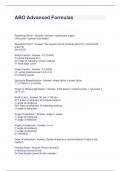Resultant prism - Study guides, Class notes & Summaries
Looking for the best study guides, study notes and summaries about Resultant prism? On this page you'll find 17 study documents about Resultant prism.
All 17 results
Sort by
![AQA GCSE COMBINED SCIENCE: TRILOGY 8464/P/2H Physics Paper 2H Version: 1.0 Final *JUN238464P2H01* IB/M/Jun23/E8 8464/P/2H QUESTION PAPER & MARKING SCHEME/ [MERGED]](/docpics/4384980/65ba8852aa454_4384980_121_171.jpeg) Popular
Popular
-
AQA GCSE COMBINED SCIENCE: TRILOGY 8464/P/2H Physics Paper 2H Version: 1.0 Final *JUN238464P2H01* IB/M/Jun23/E8 8464/P/2H QUESTION PAPER & MARKING SCHEME/ [MERGED]
- Exam (elaborations) • 51 pages • 2024
- Available in package deal
-
- $7.99
- 1x sold
- + learn more
GCSE COMBINED SCIENCE: TRILOGY 8464/P/2H Physics Paper 2H Version: 1.0 Final *JUN238464P2H01* IB/M/Jun23/E8 8464/P/2H For Examiner’s Use Question Mark 1 2 3 4 5 6 7 TOTAL Friday 16 June 2023 Morning Time allowed: 1 hour 15 minutes Materials For this paper you must have: • a protractor • a ruler • a scientific calculator • the Physics Equations Sheet (enclosed). Instructions • Use black ink or black ball-point pen. • Pencil should only be used for drawing. ...
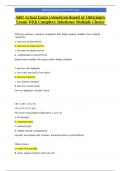
-
ABO Actual Exam (American Board of Opticianry Exam) With Complete Solutions| Multiple Choice
- Exam (elaborations) • 17 pages • 2024
- Available in package deal
-
- $12.00
- + learn more
ABO Actual Exam (American Board of Opticianry Exam) With Complete Solutions| Multiple Choice With new glasses, a patient complains that things appear smaller. this could be caused by a. increase in plus power b. increase in minus power c. decrease in minus power d. astigmatism is uncorrected minus lenses minify the image (make things smaller) A person with diplopia: a. sees only one half of an object b. sees two objects c. sees objects divided d. has low visual acuity Di=two; d...
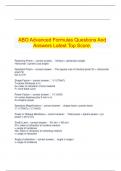
-
ABO Advanced Formulas Questions And Answers Latest Top Score.
- Exam (elaborations) • 5 pages • 2024
-
- $10.09
- + learn more
ABO Advanced Formulas Questions And Answers Latest Top Score. Resolving Prism= - correct answer. Vertical = (prism)(sin angle) Horizontal = (prism) (cos angle) Resultant Prism= - correct answer. The square root of (Vertical prism^2) + (Horizontal prism^2) tan a=V/H Shape Factor= - correct answer. 1/1-(T/NxF) T=center thickness in m N= index of refraction of lens material F= front base curve Power Factor= - correct answer. 1/1-(HxD) H= vertex distance plus 3 m...
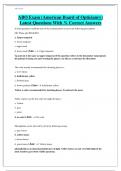
-
ABO Exam (American Board of Opticianry) Latest Questions With % Correct Answers
- Exam (elaborations) • 17 pages • 2024
- Available in package deal
-
- $11.00
- + learn more
ABO Exam (American Board of Opticianry) Latest Questions With % Correct Answers In what quadrant would the base of the resultant prism occur in the following prescription OD: Plano sph 2BU&2BO a. Upper temporal b. lower temporal c. upper nasal d. lower nasal (Ans: - A. Upper temporal Up and out is the same as upper temporal. If the question referes to the lensometer target picute the patient is facing you and wearing the glasses. use this as a reference for directions The color usually...
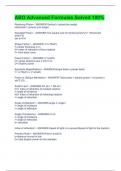
-
ABO Advanced Formulas Solved 100%
- Exam (elaborations) • 4 pages • 2023
- Available in package deal
-
- $10.49
- + learn more
Resolving Prism= - ANSWER-Vertical = (prism)(sin angle) Horizontal = (prism) (cos angle) Resultant Prism= - ANSWER-The square root of (Vertical prism^2) + (Horizontal prism^2) tan a=V/H Shape Factor= - ANSWER-1/1-(T/NxF) T=center thickness in m N= index of refraction of lens material F= front base curve Power Factor= - ANSWER-1/1-(HxD) H= vertex distance plus 3 mm in m D= Dioptric power Spectacle Magnification= - ANSWER-shape factor x power factor 1/ 1-(T/NxF) x 1/1-(HxD) ...
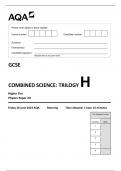
-
AQA GCSE COMBINED SCIENCE: TRILOGY H Higher Tier Physics Paper 2H 2023
- Exam (elaborations) • 140 pages • 2024
- Available in package deal
-
- $12.49
- + learn more
Light changes direction when it enters the glass prism. What name is given to this process? Use the Physics Equations Sheet to answer questions 01.4 and 01.5. 0 1 . 4 Write down the equation that links frequency (f), wavelength (λ) and wave speed The wave in the middle of the spectrum has a wavelength of 5.0 × 10–7 m. wave speed of light = 3.0 × 108 m/s Calculate the frequency of the wave. Use the Physics Equations Sheet to answer questions 02.4 and 02.5. 0 2 . 4 Write dow...
ABO Advanced Formulas
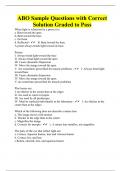
-
ABO Sample Questions with Correct Solution Graded to Pass
- Exam (elaborations) • 15 pages • 2023
- Available in package deal
-
- $10.99
- + learn more
When light is refraction by a prism it is: a. Bent toward the apex b, Bent toward the base c. Not bent d. Reflected - B. Bent toward the base A prism always bends light toward its base. Prisms: I. Always bend light toward the base II. Always bend light toward the apex III. Cause chromatic Dispersion IV. Move the image toward the apex V. Are sometimes prescribed for muscle problems - I. Always bend light toward base III. Cause chromatic dispersion. IV. Move the image toward...
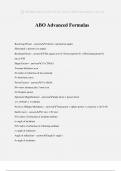
-
ABO Advanced Formulas
- Exam (elaborations) • 5 pages • 2024
- Available in package deal
-
- $10.49
- + learn more
ABO Advanced Formulas Resolving Prism= - answerVertical = (prism)(sin angle) Horizontal = (prism) (cos angle) Resultant Prism= - answerThe square root of (Vertical prism^2) + (Horizontal prism^2) tan a=V/H Shape Factor= - answer1/1-(T/NxF) T=center thickness in m N= index of refraction of lens material F= front base curve Power Factor= - answer1/1-(HxD) H= vertex distance plus 3 mm in m D= Dioptric power Spectacle Magnification= - answershape factor x power factor 1/ 1-(T/NxF) x 1/1...
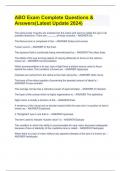
-
ABO sample Questions & Answers(Verified) When light is refraction by a prism it is: a. Bent toward the apex b, Bent toward the base c. Not bent d. Reflected - ANSWER B. Bent toward the base A prism always bends light toward its base. Prisms: I. Always
- Exam (elaborations) • 36 pages • 2024
- Available in package deal
-
- $11.99
- + learn more
ABO sample Questions & Answers(Verified) When light is refraction by a prism it is: a. Bent toward the apex b, Bent toward the base c. Not bent d. Reflected - ANSWER B. Bent toward the base A prism always bends light toward its base. Prisms: I. Always bend light toward the base II. Always bend light toward the apex III. Cause chromatic Dispersion IV. Move the image toward the apex V. Are sometimes prescribed for muscle problems - ANSWER I. Always bend light toward base III. C...

How did he do that? By selling his study resources on Stuvia. Try it yourself! Discover all about earning on Stuvia



